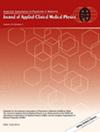Automatic image quality evaluation in digital radiography using a modified version of the IAEA radiography phantom allowing multiple detection tasks
Abstract
Purpose
To evaluate image quality (IQ) of for-processing (raw) and for-presentation (clinical) radiography images, under different exposure conditions and digital image post-processing algorithms, using a phantom that enables multiple detection tasks.
Methods
A modified version of the radiography phantom described in the IAEA Human Health Series No. 39 publication was constructed, incorporating six additional Aluminum (Al) targets of thicknesses both smaller and larger than the standard one. Raw and clinical images were simultaneously acquired using two digital radiography units from different manufacturers, various exposure parameters and different examination protocols. The phantom images were read using the free IAEA software (ATIA) that estimates automatically various IQ-metrics in images of the original phantom. Since in the modified phantom had seven Al targets, images were read seven times, one for each different Al thickness. The IQ-metrics’ values obtained were analyzed to investigate their dependence on incident air kerma on the image receptor, tube potential, examination protocol, image type (raw or clinical), Al-target thicknesses, and manufacturer.
Results
The IQ-metric values calculated using the modified IAEA phantom images can be radically different between raw and clinical images, and between different manufacturers, irrespectively whether only the standard or all the different Al-target thicknesses are considered. The modulation transfer function (MTF) and the signal-to-noise-ratio (SNR) dependence on exposure conditions and post-processing algorithms do not always follow the same trends for raw and clinical images and/or different manufacturers, while the signal-difference-to-noise-ratio (SDNR) and the detectability index (d′), despite their differences, seem more appropriate to characterize IQ. However, the d′ metric, which also considers both MTF and the normalized noise power spectrum (NNPS) should be considered more complete IQ-metric than SDNR.
Conclusions
Though theoretically d′ values should be calculated using raw images, clinical images can be also used, at least for constancy tests.


 求助内容:
求助内容: 应助结果提醒方式:
应助结果提醒方式:


